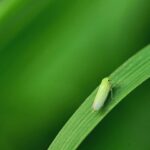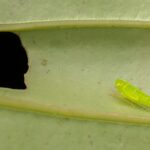Leafhopper
Leaf Feeding Insects & Mites
Leafhoppers are small, agile insects that belong to the family Cicadellidae. They are also known as plant hoppers or plant lice. Leafhoppers have a characteristic triangular shape and range in size from less than 2 mm to over 10 mm. They are typically green or brown in color and can be identified by their distinctive hopping motion.
Leafhoppers feed on the sap of plants, which they extract from the phloem, a layer of tissue found in the stems and leaves. This feeding process can result in the discoloration and wilting of leaves, and can also lead to the transmission of plant viruses. Some species of leafhoppers are known to cause significant damage to crops, particularly in the form of yellowing and stunting of growth.
Leafhoppers have a unique method of feeding, known as "pierce-and-suck". They use their sharp mouthparts to pierce the plant's phloem, which allows them to extract the sap. In addition to transmitting plant viruses, this feeding process can also introduce harmful bacteria and fungi into the plant, which can cause further damage.
Leafhoppers have a life cycle that typically consists of four stages: egg, nymph, adult, and egg-laying. During the nymph stage, they molt and change form several times before reaching adulthood. Leafhoppers lay their eggs on the underside of leaves, and the nymphs emerge and begin feeding on the plant sap.
Leafhoppers are also capable of transmitting plant diseases, as they can carry plant viruses from plant to plant as they feed. This can result in a significant reduction in crop yields and is a significant concern for farmers and gardeners.
In conclusion, leafhoppers are small insects that feed on the sap of plants, causing discoloration and wilting of leaves, stunting of growth, and transmitting plant viruses. They have a unique feeding method and a life cycle that includes four stages. Effective control of leafhoppers is essential to protect crops and maintain healthy plants.




